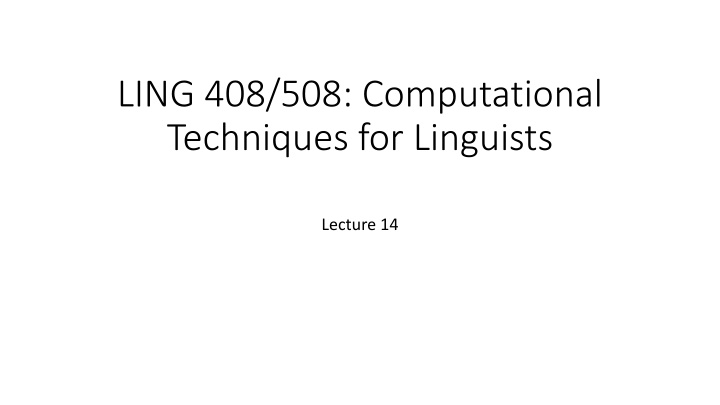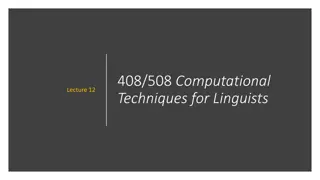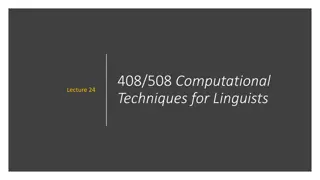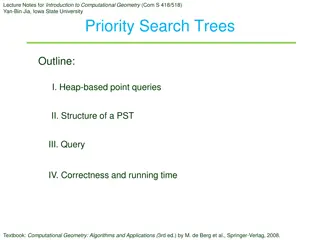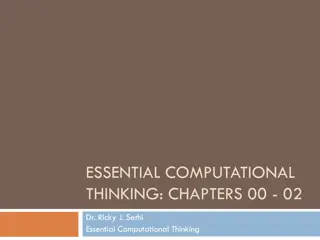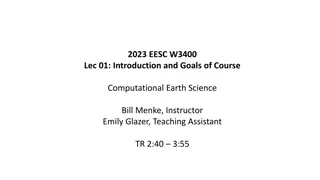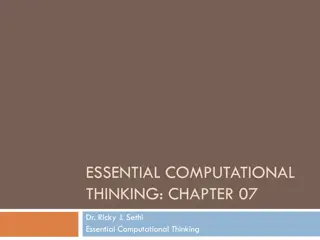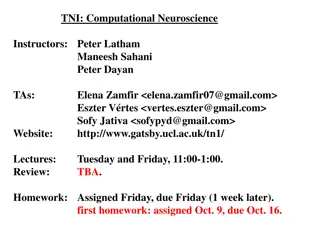Computational Techniques for Linguists: Lecture 14 Overview
Today's lecture covers topics on associative arrays in Awk, regular expressions, and managing data structures. The session delves into working with regex in Awk, building tables of word frequencies, and manipulating text data effectively. Explore the practical applications of associative arrays and regex in linguistic analysis and data processing.
Uploaded on Mar 01, 2025 | 0 Views
Download Presentation

Please find below an Image/Link to download the presentation.
The content on the website is provided AS IS for your information and personal use only. It may not be sold, licensed, or shared on other websites without obtaining consent from the author.If you encounter any issues during the download, it is possible that the publisher has removed the file from their server.
You are allowed to download the files provided on this website for personal or commercial use, subject to the condition that they are used lawfully. All files are the property of their respective owners.
The content on the website is provided AS IS for your information and personal use only. It may not be sold, licensed, or shared on other websites without obtaining consent from the author.
E N D
Presentation Transcript
LING 408/508: Computational Techniques for Linguists Lecture 14
Today's Topics Reading assignment: https://www.gnu.org/software/gawk/manual/html_node/Regexp.html Let's make sure everyone is on board with associative arrays in awk A fundamental data structure the same as: dict in Python hash in Perl gsub gensub
awk: regex awk doesn't support \d (digit) etc. from Perl, use [[:digit:]] instead
Arizona 3 and 3 of 3 Management 2 Safety 2 Office 2 Institutional 1 800-362-0101 1 800-222-1222 1 520-626-6850 1 520-621-1790 1 emergencies 1 during 1 campus 1 Police 1 Poison 1 Health 1 Center 1 Campus 1 awk: regex NR = number of lines NF = number of fields in a line variable[key] associative array variable[key] = value not case insensitive Build a table of all the words used: awk 'NR!=1 {for (i=1; i<=NF; i++) {word[$i]+=1}} END {for (x in word) { printf "%12s %d\n", x, word[x]}}' uanumbers.txt | sort k 2 -n NR!=1 (pattern) skip 1st line (!= means not equal to) NF = number of fields on a line word = associative array of frequencies | = pipe (output of awk into sort) sort k2 n = command to sort on field 2 numerically (-n)
awk: regex As we read each $1, $2, etc.. field, we populate the associative array word: 1. word["University"] = 1 2. word["of"] = 1 3. word["Arizona"] = 1 4. ... 4 5 2 5. word["of"] = 2 6. 7. 8. word["Arizona"] = 2 9 9. 10. word["Arizona"] = 3 11.
arizona 3 and 3 of 3 management 2 safety 2 office 2 campus 2 institutional 1 800-362-0101 1 520-621-1790 1 information 1 emergencies 1 university 1 biosafety 1 students 1 recorded 1 chemical 1 (tucson) 1 awk: regex Build a table of all the words used (case-insensitive): awk 'NR!=1 {for (i=1; i<=NF; i++) {word[tolower($i)]+=1}} END {for (x in word) { printf "%12s %d\n", x, word[x]}}' uanumbers.txt | sort k 2 -nr tolower(string) Return a copy of string, with each uppercase character in the string replaced with its corresponding lowercase character. Nonalphabetic characters are left unchanged. For example, tolower("MiXeD cAsE 123") returns "mixed case 123". https://www.gnu.org/software/gawk/manual/html_node/String-Functions.html
arizona 3 and 3 of 3 management 2 safety 2 office 2 campus 2 institutional 1 information 1 emergencies 1 university 1 facilities 1 department 1 biological 1 radiation 1 committee 1 biosafety 1 students 1 recorded 1 chemical 1 updates 1 service 1 tucson 1 police 1 awk: regex Build a table of all the words used (no numbers, no punctuation): gawk 'NR!=1 {for (i=1; i<=NF; i++) {gsub(/[^A-Za-z]/, "", $i); word[tolower($i)]+=1}} END {for (x in word) { printf "%12s %d\n", x, word[x]}}' uanumbers.txt | sort k 2 -nr gsub(regexp, replacement [, target]) Search target for all of the longest, leftmost, nonoverlapping matching substrings it can find and replace them with replacement. The g in gsub() stands for global, which means replace everywhere. https://www.gnu.org/software/gawk/manual/html_node/String-Functions.html
awk: gensub https://www.gnu.org/software/gawk/manual/html_node/String-Functions.html gensub(regexp, replacement, how [, target]) Search the target string target for matches of the regular expression regexp. If how is a string beginning with g or G (short for global ), then replace all matches of regexp with replacement. Otherwise, how is treated as a number indicating which match of regexp to replace. If no target is supplied, use $0. It returns the modified string as the result of the function and the original target string is not changed. gensub() provides an additional feature that is not available in sub() or gsub(): the ability to specify components of a regexp in the replacement text. This is done by using parentheses in the regexp to mark the components and then specifying \N in the replacement text, where Nis a digit from 1 to 9.
awk: gensub If only a BEGIN section, no need to provide a file (to process line by line). gawk 'BEGIN {print "hello"}' hello -v (sets variable): gawk -v n="hello" 'BEGIN {print n, "\n"}' hello gensub(regex, replacement,how, target) regex = /(.+) (.+)/ replacement = "\\2 \\1" how = "g" target = (variable) n gawk -v n="hello goodbye" 'BEGIN {print gensub(/(.+) (.+)/, "\\2 \\1", "g", n), "\n"}' What happens?
